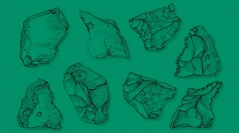

 Comptes Rendus Palevol
21 (44) - Pages 969-990
Comptes Rendus Palevol
21 (44) - Pages 969-990The technocomplexes of the European Lower Palaeolithic are often attributed to the so-called Acheulean. Through several prehistoric sites located in the South Armorican coast, a distinct and contemporary Acheulean cultural facies was proposed at the end of the 1980s. Based on the study of lithic industries at the Pointe de Saint-Colomban site in Carnac, it is called “Colombanian” and is characterised by the coexistence of macro-tools on pebbles and a variety of small tools on flakes. As is often the case, the presence or absence of handaxes is a determining criterion to qualify a lithic assemblage as “Acheulean”. However, this categorial attribution loses all meaning when a technological analysis is conducted. Consequently, we used a techno-structural approach to illustrate the technological and functional variability of lithic artefacts from the early occupations of the Pointe de Saint-Colomban site (layers 5, 6 and 7). The application of the “chaîne opératoire” principle allowed us to reveal the processes and objectives of the lithic production system and to establish a homogeneous reading grid among the different pieces of the assemblage. We present here the data from our study which clearly shows that the “Colombanian” is no longer valid and that we need to initiate a change of definition. The lithic industry of the Pointe de Saint-Colomban site is dominated by the concept of flaking (débitage) represented by numerous cores and flake tools. The concept of shaping (façonnage) is illustrated by only two sandstone pebble tools. All this highlights the diversity and originality of the lithic technical systems of the Lower Palaeolithic of the Atlantic Armorican coastline.
Western Europe, middle Pleistocene, lithic technology, technical diversity, Colombanian culture